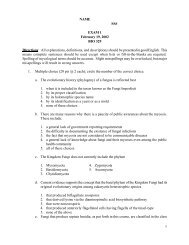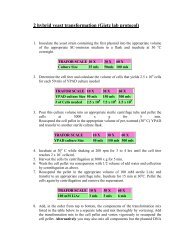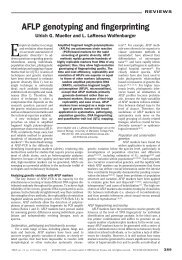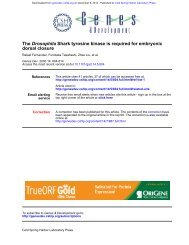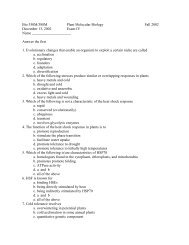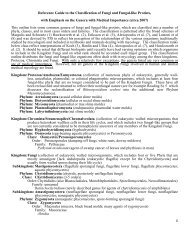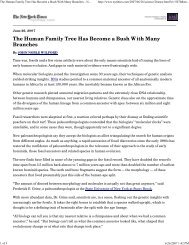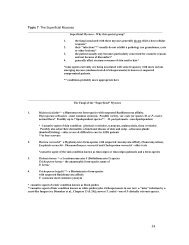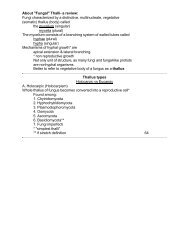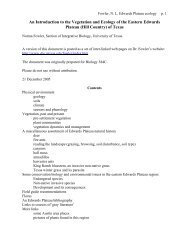Transcription and Translation RNA
Transcription and Translation RNA
Transcription and Translation RNA
You also want an ePaper? Increase the reach of your titles
YUMPU automatically turns print PDFs into web optimized ePapers that Google loves.
How are amino acids attached to a t<strong>RNA</strong>?<br />
Each t<strong>RNA</strong><br />
can only<br />
carry one<br />
specific<br />
amino acid.<br />
5'<br />
3'<br />
Amino acyl<br />
t<strong>RNA</strong> synthetase<br />
5'<br />
Threonine<br />
AGU Threonine AMP + PPi<br />
AGU<br />
ATP<br />
A t<strong>RNA</strong> carrying an amino acid is said to be charged. But the amino acid that is<br />
attached to the t<strong>RNA</strong> is said to be activated. The enzyme that attaches the amino acid to the<br />
t<strong>RNA</strong> is called aminoacyl t<strong>RNA</strong> synthetase. Charging a t<strong>RNA</strong> consumes energy in the form<br />
of ATP. Energy from the ATP is conserved in bond between amino acid <strong>and</strong> t<strong>RNA</strong>.<br />
Charged t<strong>RNA</strong><br />
Amino acid are<br />
attached to the t<strong>RNA</strong><br />
through the terminal<br />
3' adenosine residue<br />
found in t<strong>RNA</strong>.<br />
D-loop<br />
D-Stem<br />
5' end<br />
Acceptor<br />
Stem<br />
CCA<br />
end<br />
Anticodon<br />
stem<br />
TΨC loop<br />
Threonine<br />
HO<br />
CH2<br />
H<br />
O<br />
NH 2<br />
C<br />
C<br />
O<br />
N<br />
N<br />
CH(CH3)OH<br />
O<br />
t<strong>RNA</strong><br />
N<br />
NH 2<br />
N<br />
Threonine<br />
Adenylate<br />
AGU<br />
Anticodon loop<br />
The last three nucleotides on the 3' end of a t<strong>RNA</strong> are cytidylate (C) cytidylate (C) <strong>and</strong><br />
adenylate (A). That is 5' CCA 3'. Amino acids are attached to the t<strong>RNA</strong> through the<br />
adenylate residue. They are attached through a carboxylic bond to the 2' or 3' carbon of the<br />
adenylate residue.<br />
Remember that bacteria have 30 to 40 different t<strong>RNA</strong>s <strong>and</strong> eukaryotes have about 50<br />
different t<strong>RNA</strong>s. There is one amino acid synthetase for each amino acid. That is, there are<br />
20 different aminoacyl t<strong>RNA</strong> synthetases. Each individual synthetase charges all of the<br />
t<strong>RNA</strong>s that encode one particular amino acid. That is; each synthetase is specific for one<br />
amino acid. For example, if an organism has three t<strong>RNA</strong> arg 's then the enzyme arginine<br />
aminoacyl t<strong>RNA</strong> synthetase will charge all of the three t<strong>RNA</strong>s. Some aminoacyl t<strong>RNA</strong><br />
synthetases recognize their particular t<strong>RNA</strong>s based upon the shape of the molecule while<br />
others seem to recognize the anticodon loop itself.<br />
page 5.18 Revised 8/24/98



